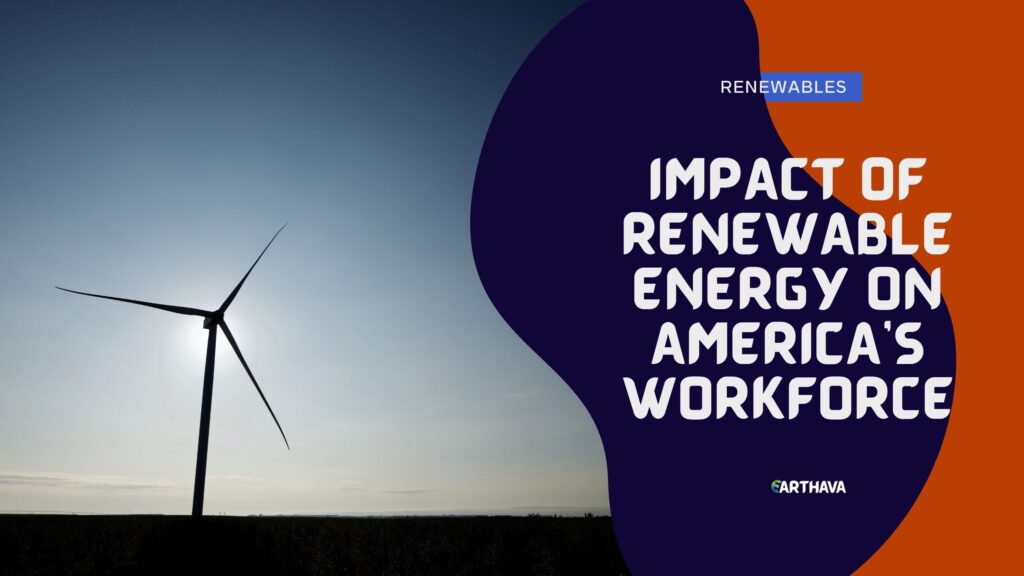Renewable energy is energy that is drawn from resources that can be naturally replenished. Renewable energy has an infinite supply that can never run out as its use is constant with its supply. These resources include wind, sunlight, geothermal heat, waves, rain, and tides. Unlike conventional energy resources like oil and coal, renewable energy can be used as many times as necessary without the need to burn the earth’s fossil fuels.

Renewable energy is a solution to both current and future fuel needs as conventional energy resource sources are running out rapidly and will not last forever. The use of renewable energy has a lot of advantages as it is a clean source of energy that doesn’t add pollutants to the environment and it has created new jobs in addition to reducing global warming.
Growth Rate Of Renewable Energy Jobs
Renewable energy gas brought about a wide variety of jobs that are distributed throughout 50 states in the USA. These jobs include installation, sales, manufacturing, project development, operations management, policy development as well as engineering. Renewable energy now makes up 64% of electricity generating installations according to a U.S. Bureau of Labor Statistics report. Employment in the renewable energy sector has been growing rapidly in the US.
Growth Rate Compared To Oil
Solar and wind have led this growth. Solar employment opportunities are currently growing at a rate of 12 times faster than the rest of the sectors in the US economy according to a recent report by the U.S. Bureau of Labor Statistics. Since 2012 renewable energy jobs in the US have had a compound annual growth rate(C.A.G.R) of 6%.
This is in contrast with jobs in the oil sector that have seen a recent decrease of – 4.25% over the same period. Solar and wind jobs have continually grown at an increasing rate of 21% annually in recent years with each creating jobs at a rate 12 times faster compared to the rest of the sections in the economy of the US.
Explaining The Growth In Renewable Energy Jobs
The rapid growth in renewable energy jobs can be explained by the significant reductions in manufacturing and installation costs that accompany its adoption. Investing in renewable energy is more energy than using conventional energy resources like oil. There has been an increased investment in building development because of state and local government regulations. The state and local governments also fuel growth in renewable energy jobs through incentives and local efficiency policies drawn to oversee energy requirements.
Energy policies have added growth of approximately 8-10 jobs compared to only 3 created in extracting oil. Clean vehicle manufacturing by vehicle manufacturers has helped accelerate this growth with a transition towards hybrid vehicles that use renewable energy in recent years.
Over 175000 workers were employed in 2016 – a 48% increase from 2015 according to a report by the U.S. Bureau of Statistics. Due to the continued large cost reductions, jobs in the renewable energy sector are projected to see significant growth in the coming decades.
Impact On The U.S.A. Economy
Renewable energy industries are growing steadily and as a result, they create new employment opportunities that pay above average. These employment opportunities are spread all over across the US in all the states thus they provide economic stability to all Americans. Investments in renewable energy have resulted in energy savings and sustainability.
This has impacted the US economy positively because these investments create more jobs per dollar invested that would have been used alternatively to pay for energy bills in conventional fuel usage. Thus improving the lives of Americans and supporting local American economies. Renewable energy offers several opportunities for economic growth by creating new jobs, increasing incomes, and improving the general public and workers’ health.
The use of renewable energy is projected to grow by 0.6% of the GDP by 2030 in the USA and will increase employment by one million net people. With reduced energy expenditure, jobs are bound to grow resulting in more production of goods and services. The public and private sectors have set goals to promote sustainability.
Sustainability will help reduce global warming by cutting down on greenhouse emissions. Large corporations have increased investment in renewable energy through technological advancements.
Renewable energy has seen a growth in technological developments, especially in the automotive industry as vehicle manufacturers move towards developing clean fuel-using vehicles. These vehicle manufacturers employ over one hundred and seventy-five thousand head counts of workers according to the US Bureau of Labor Statistics across the US.
Clean fuel manufacturers offered jobs ranging from installations to repair technicians and mechanical engineers. State and local government regulations, existing demand for clean fuel vehicles, and adoption of new technology are the factors that are expected to present more employment opportunities in the future of renewable energy.
The private sector has embraced sustainability by focusing on meeting the existing market demand for sustainable products and improving its corporate social responsibility. A survey by GreenBiz in 2016 found that over seventy-five percent of firms had dedicated budgets for sustainability. Many private firms are integrating sustainability as a function across every department in the company rather than making it a one-department affair.
Corporate social responsibility is one way through which firms show that they care about surrounding communities and the environment. Firms have taken measures to show that they care about the environment as well as the health of people living around the company’s locality by engaging in producing ‘green products.’ These are products that help reduce greenhouse emissions and hence reduce global warming.
Research shows that sustainability investments in local and state governments’ regulations and energy savings are the driving force in the recent shift towards the adoption of renewable energy. The use of renewable energy offers solutions to present and future fuel needs and demands. Its use should be embraced as conventional energy resources are being depleted at a very high rate as well and their use contributing to global warming.


